I. Revolutionizing Commercial TV: An Introduction to Dish Network’s SmartBox
A. The Evolving Landscape of Commercial Video Distribution
Providing television services in multi-room commercial environments, such as hotels, apartment complexes, and healthcare facilities, has traditionally been a complex and costly undertaking. Property owners and managers often grappled with bulky equipment racks consuming significant space, extensive and often proprietary cabling networks, high energy consumption, and challenging management overhead. The demand for high-definition content, diverse channel lineups, and reliable service further compounded these challenges. As technology advanced, the need for more streamlined, efficient, and high-quality solutions became increasingly apparent, pushing the industry towards innovations that could simplify operations while enhancing the end-user experience.
B. Enter SmartBox: Dish Network’s Vision for Centralized Entertainment
Dish Network’s SmartBox emerged as a strategic response to these industry-wide challenges. It represents a vision for centralized entertainment delivery, offering a compact and intelligent video distribution platform specifically designed for businesses. The core purpose of the SmartBox is to simplify the delivery of a wide array of TV channels across various property types, from satellite signal reception to distribution throughout a facility. This approach marked a significant shift from decentralized, cumbersome setups to a more integrated “headend-in-a-box” model. The system was conceived to alleviate the operational burdens and high costs associated with legacy commercial TV systems, positioning itself as a solution that directly addresses these long-standing pain points for property managers by promising reduced operational costs, easier installations without extensive rewiring, and lower power consumption.

II. Unpacking the SmartBox: Core System and Evolution
A. Defining the SmartBox: The “Headend in a Box” Concept Explained
The SmartBox fundamentally redefines commercial video headends by integrating multiple essential functions into a single, compact chassis. These functions traditionally required a rack full of separate components, including satellite receivers, channel processors, modulators, and distribution management systems. The SmartBox consolidates these, converting satellite-delivered TV channels for efficient distribution over various types of in-property networks, including existing coaxial cable, Ethernet (IP networks), and fiber optic infrastructure. This “headend-in-a-box” concept is central to its value, offering a powerful yet simplified approach to managing and delivering television services across an entire property.
B. The Journey: From the Original SmartBox to the Enhanced SmartBox 2
The SmartBox platform has evolved to meet the growing demands of the commercial market, with distinct generations offering progressively enhanced capabilities.
1. The Original SmartBox (5RU): The Foundation
The first-generation SmartBox, typically housed in a 5 Rack Unit (5RU) chassis, laid the groundwork for Dish Network’s innovative approach to commercial TV. Described as being “slightly bigger than a microwave,” it was already a significant departure from sprawling traditional headends. This initial iteration could deliver up to 96 satellite channels and was lauded for its substantial power and space savings compared to conventional systems. Its physical dimensions were approximately 8.75 inches in height, 17.75 inches in width, and 15.8 inches in depth.
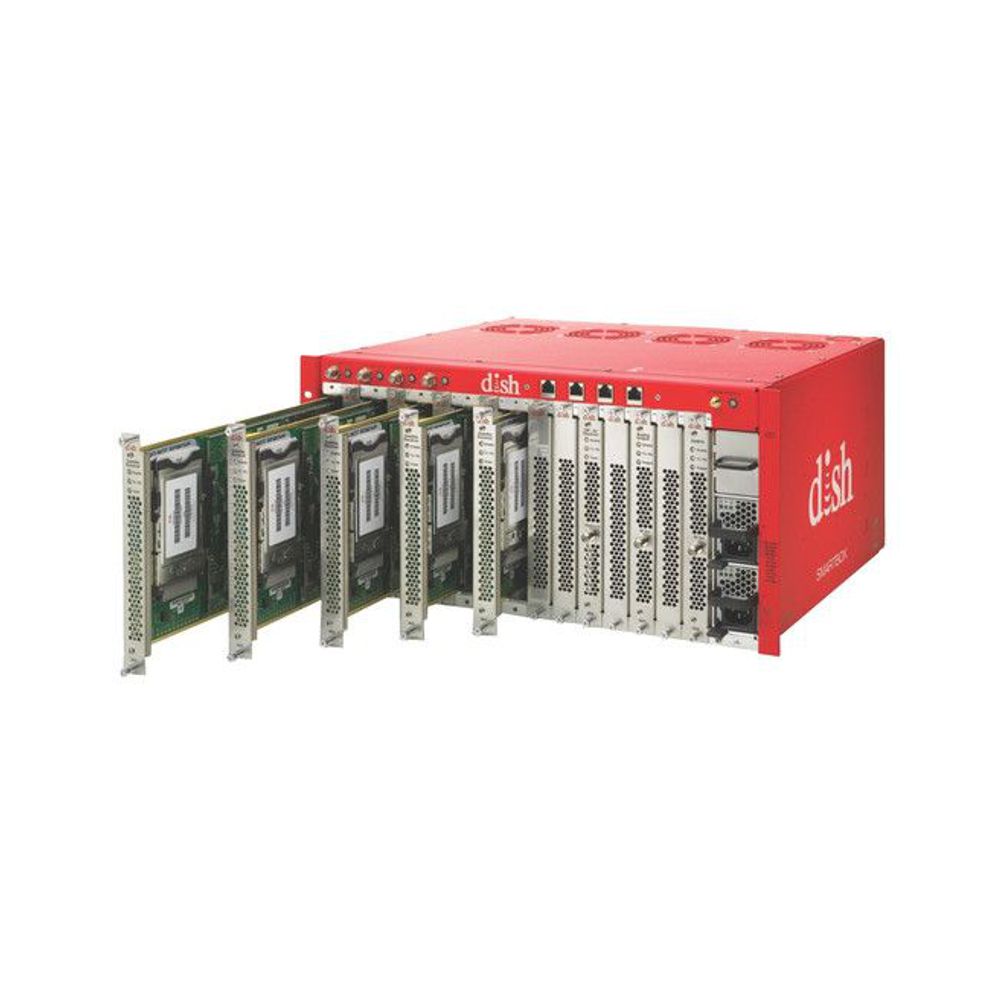
2. SmartBox 2 (3RU): More Power, Less Space, Enhanced Capabilities
Introduced around September 2021, the SmartBox 2 represents the next generation of this platform, packing even more power and features into a smaller footprint. Key improvements include the capacity to deliver up to 192 HD channels and support for 4K HD content, catering to the increasing demand for higher resolution viewing experiences. The chassis size was reduced to a more compact 3RU, making it “nearly half the size of its predecessor” and further increasing energy efficiency by being approximately “50% more efficient than SMARTBOX” or, as another source states, “twice as efficient”. The dimensions of the SmartBox 2 are approximately 5.25 inches in height, 17.75 inches in width, and 17.1 inches in depth. A significant technological upgrade in the SmartBox 2 is the inclusion of a 10 Gigabit SFP+ port, enhancing its capabilities for IP-based video delivery and integration with modern network infrastructures. This iterative improvement demonstrates a clear response to evolving market needs, addressing the demand for more channels, higher resolutions, and robust IP integration.
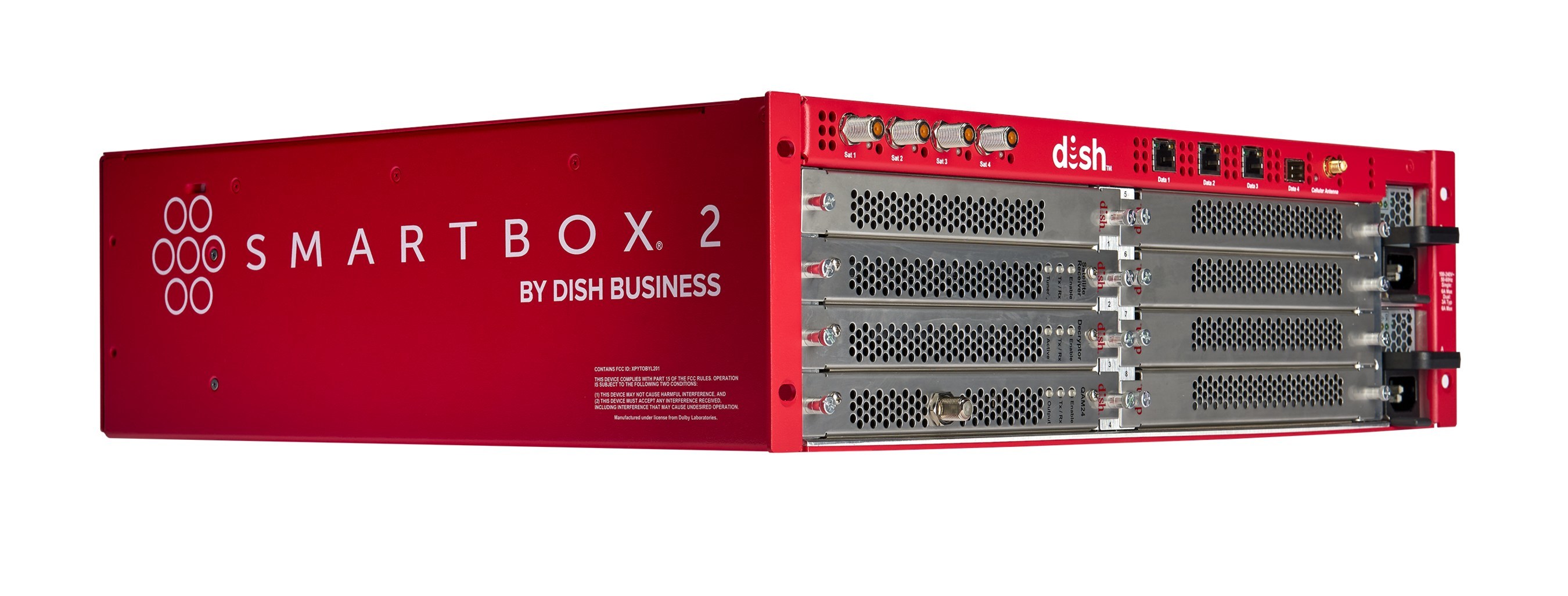
C. Core Value Proposition: Efficiency, Scalability, and Cost-Effectiveness for Properties
Across both generations, the SmartBox platform has consistently aimed to deliver significant operational and financial benefits. The core value proposition revolves around reducing operational costs through lower energy consumption and less need for dedicated, cooled equipment rooms; saving valuable physical space; and providing a scalable solution that can adapt to future technological advancements and property expansions. As Dish Business states, “SMARTBOX technology supports any size property over any type of infrastructure while offering custom solutions that meet your business needs”. The consistent reference to SmartBox as a “platform” rather than just a device underscores its modularity and potential for expanded capabilities, hinting at a system designed for adaptability and growth beyond its primary video distribution role.
III. Powerhouse Features & Tangible Benefits for Your Property
The Dish Network SmartBox system, in both its original and SmartBox 2 iterations, offers a compelling suite of features designed to provide tangible benefits to commercial properties. These features collectively contribute to a more efficient, manageable, and high-quality television experience for guests and residents, while also addressing the operational concerns of property owners.
A. Extensive Channel Lineups: Delivering HD and 4K Content
A primary function of the SmartBox is to deliver a rich selection of television programming. The original SmartBox could provide up to 96 HD channels. The SmartBox 2 significantly expands this capacity, offering up to 192 HD channels and, crucially, support for 4K HD content. This ability to deliver a wide variety of high-definition and ultra-high-definition programming is paramount for meeting the expectations of today’s viewers in hotels, MDUs, and other commercial settings.
B. Significant Space and Energy Savings
One of the most impactful benefits of the SmartBox platform is its efficiency in terms of space and energy. The original 5RU SmartBox was already compact, but the SmartBox 2, at 3RU, takes up even less space – reportedly 40% less than its predecessor. Compared to traditional, sprawling headend systems, the space savings can be dramatic, with some claims of up to 93% reduction.
Energy savings are equally impressive. The original SmartBox was designed to consume less than 300 watts of power for a 40-channel HD lineup. The SmartBox 2 is stated to be up to 50% more energy-efficient than the original. Overall, properties can see up to 90% less power consumption compared to older, traditional cable and satellite headend systems. These efficiencies translate directly into lower utility bills and a reduced environmental footprint, freeing up valuable equipment room space and often eliminating the need for expensive, dedicated cooling systems.
C. Seamless Integration: Leveraging Existing Infrastructure
A key design principle of the SmartBox is its ability to integrate with a property’s existing wiring infrastructure. It is compatible with coaxial cable, Ethernet, and fiber optic setups. This flexibility minimizes the need for costly and disruptive rewiring projects during installation, allowing for faster and more cost-effective deployment. The system supports “HD Over Coax” capabilities, often utilizing transcoding technology to deliver digital signals over existing analog-era cabling.
D. Advanced Remote Management and 24/7 Monitoring
The SmartBox platform is designed for robust remote oversight. SmartBox 2 boasts “complete remote management capabilities”. Dish Business provides 24/7 remote monitoring by off-site technicians, enabling proactive issue detection and resolution, often before they impact service. The original SmartBox incorporated a built-in wireless 4G modem specifically for this purpose, allowing for real-time system health monitoring and remote maintenance by Dish system integrators. This level of remote support reduces downtime and lessens the burden on on-site technical staff, which is particularly valuable for properties without dedicated AV/IT personnel.
E. Tailored Viewing: Customizable Program Guides and Private Channels
To enhance the user experience and allow for property-specific branding, SmartBox offers customizable program guides and the ability to create private or welcome channels. These features enable properties to tailor the on-screen presentation, provide targeted information to guests or residents (e.g., hotel amenities, community announcements), and reinforce their brand identity. This contributes to a more engaging and personalized viewing experience.
F. Content Security: Robust Digital Rights Management (DRM)
Delivering premium HD content in commercial environments necessitates strong content protection. The SmartBox platform supports industry-standard Digital Rights Management (DRM) technologies such as Pro:Idiom® and Verimatrix Video Content Authority System™ (VCAS). This is essential for legally providing access to encrypted high-definition channels from content providers like HBO, Showtime, and others, ensuring compliance and protecting against piracy. This careful balance between robust content protection and user convenience is critical in the commercial video solutions market.
G. Built-in Redundancy for Uninterrupted Service
To ensure high availability and minimize service disruptions, SmartBox systems are engineered with redundancy in mind. Features include redundant power supplies and cooling fans. The system is built with enterprise-grade components designed for continuous operation, aiming to reduce the likelihood of mechanical issues and maintain a consistent TV experience for users.
H. Streamlined In-Room Experience: Reducing or Eliminating Set-Top Boxes
Depending on the specific configuration and the type of televisions used in a property (e.g., hospitality TVs with built-in Pro:Idiom decryption), SmartBox solutions can reduce or even eliminate the need for individual set-top boxes (STBs) in each room. This leads to a cleaner, less cluttered in-room environment, simplified remote controls for users, and potentially lower overall equipment and maintenance costs for the property owner.
The multifaceted benefits offered by SmartBox illustrate a holistic approach to commercial TV solutions. It’s not merely about delivering channels; it’s about enhancing operational efficiency, achieving cost savings in installation and ongoing maintenance, improving the end-user experience through customization and high-quality content, and ensuring future-readiness with IP integration and robust DRM.
IV. Under the Hood: A Technical Deep Dive into SmartBox Architecture
The Dish Network SmartBox achieves its impressive capabilities through a sophisticated and modular hardware architecture. Understanding its technical underpinnings reveals a platform designed for flexibility, efficiency, and future adaptability.
A. Hardware Foundation
1. Chassis Design and Evolution
The original SmartBox established the compact headend concept with its 5RU chassis, measuring approximately 8.75” H x 17.75” W x 15.8” D. This unit could be either wall-mounted or installed in standard equipment racks, offering flexibility in various equipment room scenarios. Integrated cooling fans were a key feature, ensuring reliable operation without requiring heavily air-conditioned environments.
The SmartBox 2 further refines this design, shrinking to an even more compact 3RU chassis with dimensions of approximately 5.25” H x 17.75” W x 17.1” D. It features a rear venting exhaust system for thermal management.
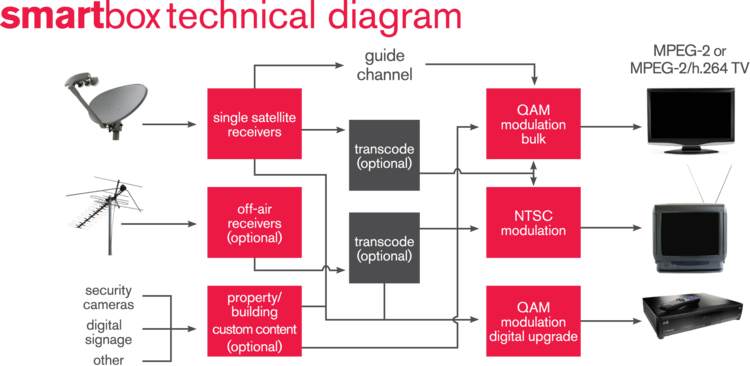
An illustration available from some third-party integrators, like Don-Lors Electronics, depicts the front panel of what appears to be the original 5RU SmartBox chassis. This diagram visually identifies key external and internal-access components: Four LNB (satellite input) ports and four Ethernet data ports are shown, typically located on the front for easy access. The chassis houses slots for various input blades (such as Satellite Receiver Blades and ATSC Receiver Blades for off-air channels) and output blades (including QAM and Analog modulators). Large, top-mounted fans are highlighted as part of the integrated cooling system. A cellular modem antenna for communication with the DISH Network Operations Center and a fully redundant power supply are also noted as critical components in this visual representation.
2. Modular Prowess: The Role of Hot-Swappable Blades
A cornerstone of the SmartBox’s flexibility and longevity is its modular, blade-based architecture. Dish describes it as having “fluid technology… designed to evolve… with just the switch of a blade”. This design allows properties to customize the SmartBox to their specific input and output requirements and adapt to future technological changes without replacing the entire chassis.
- Satellite Receiver Blade: Each blade typically features eight tuners, capable of processing eight distinct TV services or transponders. The original SmartBox could support up to 12 such blades, enabling a capacity of up to 96 channels. These blades support various satellite modulation standards, including DVB-S, DVB-S2, and Turbo FEC, with multiple QPSK and 8PSK schemes.
- QAM Output Blade: These blades modulate the processed TV signals into Quadrature Amplitude Modulation (QAM) format for distribution over coaxial cable networks. Options are available for 16, 48, or even 96 QAM carriers, supporting standards like ITU-T J.83 Annex A/B (256QAM).
- NTSC Analog Blade: For properties still utilizing analog televisions or requiring analog distribution (e.g., for some fitness equipment), NTSC analog blades can provide up to 24 analog channels per blade.
- ATSC Receiver Blade: To integrate local off-air channels, ATSC receiver blades can be added, typically providing up to eight local TV stations or services per blade.
- Transcoder Module/Blade: Transcoding capabilities are crucial for format conversions, such as changing MPEG-4 streams to MPEG-2 for compatibility with older “HD-Over-Coax” installations or specific TV models. Some MDU installations have utilized “streaming blades” for IP-based delivery.
3. Connectivity Hub
The SmartBox chassis serves as a central connectivity point:
- LNB Inputs: Typically includes four F-Female connectors for direct connection to satellite dish LNBs, providing the raw satellite signal feeds.
- Ethernet Ports: Multiple RJ-45 Gigabit Ethernet ports are provided for system management and IP-based video input/output. The SmartBox 2 significantly enhances this with three Ethernet ports and one 10 Gigabit SFP+ port, catering to high-bandwidth IP video requirements and future edge applications.
- Streaming Ports (SmartBox 2): The SmartBox 2 is equipped with ports that explicitly support HD, analog, and streaming content delivery, reflecting the growing importance of IP-based distribution.
- Other Ports: Depending on the configuration, dedicated analog output ports and connections for Over-The-Air (OTA) antenna integration are also available.
4. Signal Flow Overview (Functional Diagram)
Technical documentation, such as the “SmartBox functionality” diagram referenced in specification sheets, illustrates the internal signal path. Satellite signals (and optional off-air antenna signals) enter their respective receiver modules (blades). These signals can then be routed through an optional transcoding stage if format conversion (e.g., to MPEG-2 or MPEG-2/H.264) is required. After processing, the signals are directed to the appropriate output modules for QAM modulation (typically Annex B for North America), IP output for network-based distribution, or NTSC analog modulation. These modulated signals then feed the property’s internal distribution network (coax, Ethernet). The diagram also often indicates the capability to inject locally generated content, such as a property guide channel or a welcome screen, into the channel lineup.
B. Key Technical Specifications
The following tables summarize key technical specifications, highlighting the evolution from the original SmartBox to the SmartBox 2.
| Feature | Original SmartBox | SmartBox 2 |
|---|---|---|
| Chassis Size (RU) | 5RU | 3RU |
| Max HD Channel Output | Up to 96 | Up to 192 |
| 4K Support | No (typically HD) | Yes |
| Key Network Ports | Multiple GbE | 3x GbE, 1x 10Gb SFP+ |
| Power Efficiency | Baseline | Up to 50% more efficient than original SmartBox |
| Space Saving | Significant vs. traditional | Approx. 40% less space than original SmartBox |
| Edge Compute Potential | Limited (primarily video) | Yes (based on Visium MD platform) |
| Specification | Original SmartBox | SmartBox 2 |
|---|---|---|
| General | ||
| Chassis Dimensions (H x W x D) | 8.75” x 17.75” x 15.8” | 5.25” x 17.75” x 17.1” |
| Chassis RU Size | 5RU | 3RU |
| Weight | Approx. 40 lbs | Not specified, likely lighter |
| Mounting Options | Rack/Wall | Rack/Wall |
| Performance | ||
| Max HD Channel Output | 96 | 192 |
| 4K Content Support | No | Yes |
| Supported Video Outputs | HD, SD, Analog | HD, Analog, Streaming (IP) |
| Connectivity | ||
| LNB Satellite Inputs | 4x F-Female (typical) | Similar (not explicitly detailed but implied) |
| Ethernet Ports | 4x GbE RJ-45 (typical) | 3x GbE RJ-45, 1x 10Gb SFP+ |
| Blades & Modularity | ||
| Max Input Blade Slots | Up to 12 (Satellite Receiver) | Not explicitly stated, but supports higher channel density |
| Available Blade Types | Satellite Receiver, QAM, NTSC, ATSC, Transcoder | Similar, with enhanced capabilities (e.g., for 4K, streaming) |
| Power & Environment | ||
| Input Voltage | 90-264 VAC, 47-64 Hz | Similar (standard commercial power) |
| Max Power Consumption | 1200W (Chassis Max) | Lower due to higher efficiency |
| Typical Power Consumption | <300W for 40 HD channels | Significantly less for equivalent load |
| Operating Temperature | 0-50°C (up to 122°F) | Similar, designed for non-cooled rooms |
| Management & DRM | ||
| Remote Management | DISH monitoring via 4G modem | Complete remote management, monitoring APIs |
| Supported DRM | Pro:Idiom®, VCAS™ | Pro:Idiom®, VCAS™ (and likely others) |
C. The ATX Connection: Based on the Visium MD Platform
An important aspect of the SmartBox’s hardware foundation is its origin in ATX Networks’ Visium MD platform. Both the original SmartBox and the more current SmartBox 2 are based on this technology, with SmartBox 2 specifically leveraging the ATX Visium MD8 platform. ATX is a well-established provider of commercial video service gateways and related broadcast equipment. This Original Equipment Manufacturer (OEM) relationship allows Dish Network to leverage proven, robust hardware technology while focusing on service delivery, content packaging, and overall system integration. The Visium MD platform itself is engineered for bulk media distribution across various commercial sectors and supports diverse delivery methods including cable, satellite, and IP. This strategic partnership lends credibility to the SmartBox hardware and ensures it is built upon a foundation designed for the rigors of commercial deployment.
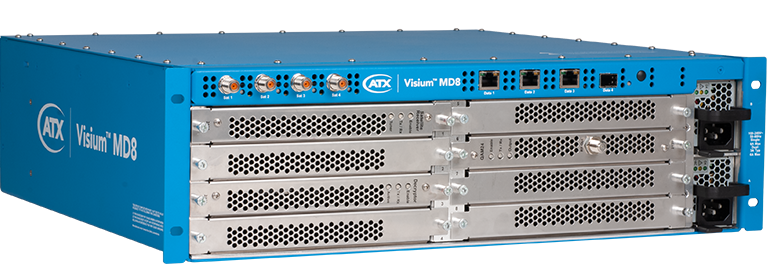
D. Future-Ready: Edge Compute Capabilities
The reliance on the ATX Visium MD platform brings an exciting dimension to the SmartBox 2: edge compute capabilities. The Visium MD is positioned by ATX as an ideal edge compute platform, featuring an “Edge Compute Blade.” This specialized processing blade can be configured to host various applications, enabling operators or system integrators to manage, monitor, and control deployed services within a secure, containerized environment directly on the SmartBox device.
Dish Business has demonstrated the SmartBox 2 supporting a range of applications beyond traditional video delivery, including a 5G mobile core, hospitality Property Management System (PMS) integration, network routing, and virtual firewall management. This capability transforms the SmartBox from a dedicated video gateway into a versatile multi-service platform located at the property edge. It allows for the consolidation of multiple hardware functions onto a single, compact device, potentially simplifying a property’s technology stack and opening new avenues for service delivery and operational efficiency. The inclusion of a 10Gb SFP+ port on the SmartBox 2 is a critical enabler for these high-bandwidth edge applications, signaling a strategic direction towards a more integrated and powerful edge device.
V. SmartBox Across Industries: Tailored Solutions for Diverse Needs
The Dish Network SmartBox platform, with its inherent flexibility and scalability, has found application across a wide spectrum of commercial industries. Its ability to be configured with different blade modules and support various output types allows it to meet the distinct entertainment and information delivery needs of diverse environments.
A. Hospitality Sector (Hotels, Resorts): Enhancing the Guest Experience
The hospitality sector is a primary target market for SmartBox solutions. For hotels and resorts, the system offers numerous benefits aimed at enhancing the guest experience and streamlining operations. These include the delivery of premium HD and 4K channels, customizable welcome screens and interactive program guides, robust Pro:Idiom® encryption for secure content delivery, and potential integration with Property Management Systems (PMS). The reduction or elimination of in-room set-top boxes contributes to a cleaner room aesthetic and simpler user interface for guests.
Several case studies illustrate SmartBox’s deployment in hotels:
- Delamar Hotel Collection: This luxury hotel group utilizes SmartBox 2 to deliver up to 192 HD channels with 4K content. The system was integrated with their existing network, avoiding costly rewires, and powers entertainment with or without set-top boxes. It features customizable guides and seamless OTA integration, and is part of a comprehensive in-room solution that includes the WorldVue HUB™ for streaming apps and PMS/room control integration.
- The Leo Kent Hotel: This Tucson boutique hotel employs SmartBox 2 by DISH Business in conjunction with Marriott’s Guest Room Entertainment (GRE) platform.
- Beachcomber Hotel Group: This group of family-owned properties uses SMARTBOX technology by DISH Business along with the WorldVue HUB™ and Chromecast solutions for guest casting.
For hotels, Dish and its partners often highlight specific SmartBox configurations like the “Analog SmartBox option” and the “Pro-Idiom SmartBox option”. The Analog SmartBox option is positioned for medium to large hotels seeking an affordable way to deliver good picture quality without in-room boxes, using an analog output from the SmartBox 2. The Pro-Idiom SmartBox option, requiring hospitality-grade TVs with built-in Pro:Idiom decryption, delivers a full 1080p HD experience and also eliminates the need for additional in-room equipment, offering a premium solution.
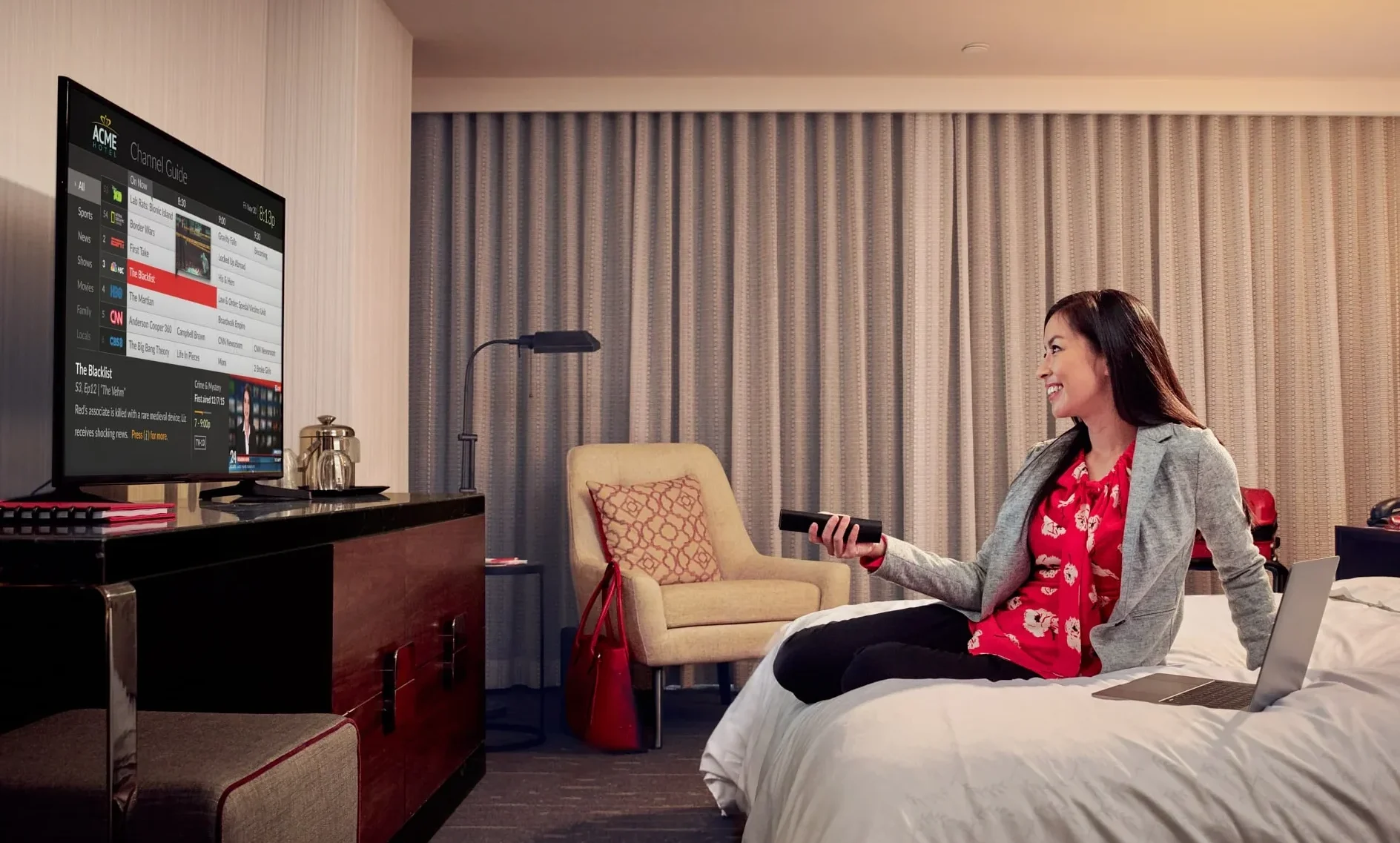
B. Multi-Dwelling Units (MDUs): Simplified, High-Quality TV for Residents
Multi-Dwelling Units (MDUs), such as apartment complexes and condominiums, represent another significant market for SmartBox solutions. For MDU property owners and managers, SmartBox offers a way to provide bulk television programming as a valuable amenity to attract and retain residents, potentially creating an additional revenue stream. Depending on the plan, no in-home receivers may be necessary for residents to access the bulk programming.
A notable MDU case study is the Economist MDU in Denver. This 97-unit complex was equipped with DISH Fiber and a SmartBox featuring a “streaming blade.” The system delivers 24 bulk channels (selected from America’s Top 120 lineup plus local channels via an OTA antenna) directly to any browser-enabled device connected to the property’s DISH Fiber network. Residents can access these channels using the OnStream App, for instance, on 4K Amazon Fire Sticks provided by the property. This installation highlights the SmartBox’s capability for IP-based streaming delivery within an MDU environment, showcasing its adaptability beyond traditional coax distribution.
C. Senior Living Communities: Accessible and Engaging Entertainment
Senior living communities are a key vertical for DISH Business, and SmartBox technology forms the hardware foundation for their tailored solutions in this sector. The benefits for these facilities focus on ease of use for residents and staff, including simplified interactive program guides with larger on-screen text, the integration of community-specific channels (e.g., for announcements or activity schedules), and compatibility with the existing televisions residents may bring from home. Remote management capabilities are particularly valuable, reducing the technical burden on facility staff. Dish reports that its SmartBox technology powers over 2 million units across all 50 states, with a significant presence in senior living. Testimonials from directors of assisted living facilities emphasize the positive impact on residents’ quality of life through enhanced entertainment options.

D. Other Commercial Applications
The versatility of the SmartBox extends to a variety of other commercial settings. These include bars and restaurants, fitness centers, public and private offices, lobbies, retail spaces, hospitals, correctional facilities, and RV parks. The system’s flexibility allows for different programming in different areas of a property; for example, providing HD channels in public viewing areas and guest rooms, while delivering analog programming to exercise equipment in a gym. This adaptability across diverse verticals is a testament to its configurable nature, allowing the core platform to be tailored via different blade modules and software settings to meet specific market segment requirements.
For MDUs and Senior Living communities in particular, SmartBox enables a “TV as an Amenity” strategy. Property owners can bundle television services into rent or fees, enhancing the attractiveness of their property and potentially generating new revenue, while often providing residents with services at a lower cost than individual subscriptions. The Economist MDU case study, where residents appreciated paying less and having immediate service availability, underscores this value proposition.
VI. SmartBox 2 in the Competitive Landscape
Dish Network’s SmartBox 2 operates in a competitive market for commercial video distribution solutions. Its primary competitor often cited is DirecTV’s COM3000 system. Understanding the distinctions helps clarify SmartBox 2’s positioning and strengths.
A. Head-to-Head: SmartBox 2 vs. DirecTV COM3000
Both SmartBox 2 and the DirecTV COM3000 are designed as compact, centralized headend solutions tailored for commercial properties like hotels and MDUs. However, they differ in several key aspects:
- Method of Distribution: SmartBox 2 is often highlighted for its ability to use a single wire to deliver both satellite and IP signals. In contrast, the COM3000 system traditionally uses multiple satellite dishes feeding into a centralized distribution hub. The “single wire” approach of SmartBox 2 could offer installation advantages in certain scenarios.
- Channel/Tuner Capacity:
- SmartBox 2: Sources indicate SmartBox 2 can deliver “up to 192 HD channels”. Some comparisons mention it supports “up to 16 tuners”. This apparent discrepancy might be reconciled if each “tuner” or processing unit on a blade can handle multiple channels simultaneously (e.g., by processing an entire satellite transponder, which carries several channels). For instance, the original SmartBox’s satellite receiver cards featured eight tuners, each capable of descrambling a TV service or passing through a full transponder. If SmartBox 2 uses a similar architecture with more powerful or more numerous blades, achieving 192 channels from a base of “16 tuners” (perhaps representing two highly capable 8-tuner cards or a different configuration) becomes plausible. This detail is crucial for accurate comparisons and understanding system density.
- DirecTV COM3000: This system is often stated to support up to 138 channels per chassis.
- Advanced Features: Both platforms offer 4K resolution capabilities. SmartBox 2 marketing often emphasizes its comprehensive remote management features, while the COM3000 is noted for a user-friendly interface.
- Content Encryption: Both systems rely on Pro:Idiom® encryption to secure premium HD content, necessitating the use of Pro:Idiom compatible hospitality TVs or external converter boxes.
- Value Proposition: Dish frequently positions SmartBox as a highly cost-effective solution, claiming it operates “at a fraction of our competitors’ prices”. This cost angle is a significant part of its competitive strategy.
B. Other Competitive Factors
Beyond direct product comparisons, Dish Network emphasizes its nationwide support infrastructure and the advantage of a single-provider solution for both hardware and programming. The SmartBox’s compatibility with existing property wiring (coaxial, Ethernet, or fiber) is also a key differentiator, potentially reducing installation complexity and cost compared to systems that might necessitate more extensive rewiring. The platform competes not just on raw channel count but also on its distribution methodology, potential for cost savings, and advanced features like robust remote management and the emerging edge compute capabilities.
VII. Deployment & Management: Practical Considerations
The practical aspects of deploying and managing the Dish Network SmartBox are key to its appeal for commercial properties. The system is designed to simplify installation, reduce ongoing maintenance burdens, and ensure long-term reliability.
A. Installation Advantages
SmartBox installations are promoted as being “quick and efficient,” largely due to the high level of integration within the chassis, which consolidates signal processing functions that traditionally required multiple discrete components. A significant advantage is its ability to utilize a property’s existing wiring infrastructure—be it coaxial cable, Ethernet, or fiber optic lines. This compatibility drastically reduces or eliminates the need for costly and disruptive rewiring projects, which is a major concern for established properties.
The compact chassis design (5RU for the original, 3RU for SmartBox 2) allows for flexible installation options. The units can be placed in existing, often small, equipment rooms and can be either rack-mounted or wall-mounted. Some models feature front-facing connections and easily replaceable components, further simplifying installation and maintenance access in tight spaces.
B. Remote Oversight & Management Interface
A cornerstone of SmartBox’s operational efficiency is its robust remote management and monitoring capabilities. Dish Network provides 24/7 remote monitoring by its off-site technicians, allowing for proactive system health checks and issue resolution. The original SmartBox utilized an integrated wireless 4G modem to communicate with Dish’s Network Operations Center, enabling Dish system integrators to perform real-time monitoring and remote maintenance.
SmartBox 2 enhances these capabilities further, offering “complete remote management capabilities” and “improved remote management plus monitoring APIs”. While Dish technicians handle much of the proactive monitoring, some documentation suggests that hotel management could view a service dashboard with the original SmartBox to stay informed about TV services. However, the specific details regarding the extent of direct management access or the nature of the monitoring APIs available to property staff (as opposed to Dish technicians) are not extensively detailed in publicly available materials. The focus appears to be on Dish providing a managed service with high reliability, reducing the need for deep technical intervention by property staff.
C. Long-Term Reliability and Support
The SmartBox platform is engineered for long-term reliability, utilizing enterprise-grade components to withstand continuous operation. Features such as redundant power supplies and integrated cooling fans contribute to system stability and uptime. Dish Network offers nationwide support for its SmartBox solutions. Typically, warranties on installation parts, accessories, and associated televisions are standard manufacturer’s warranties. Service contracts are often available, with potential discounts for 3- and 5-year agreements. For properties participating in Private Cable Operator (PCO) programs, agreements can start from as little as 36 months.
The emphasis on using existing wiring, compact and energy-efficient hardware, and comprehensive remote monitoring all contribute to a lower Total Cost of Ownership (TCO). These factors reduce not only upfront capital expenditure on new cabling or extensive room renovations but also ongoing operational costs related to power, cooling, and on-site technical interventions.
VIII. Conclusion: The SmartBox Advantage for Modern Properties
A. Recap of Key Benefits and Technological Strengths
Dish Network’s SmartBox platform, particularly with the advancements in SmartBox 2, represents a significant leap forward in commercial television distribution. Its key benefits are compelling: substantial space and energy efficiency compared to traditional headends, impressive HD and 4K channel capacity, and seamless integration with existing property wiring (coaxial, Ethernet, or fiber). The modular, blade-based architecture provides unparalleled flexibility and customization, allowing properties to tailor the system to their specific needs. Furthermore, robust remote management and 24/7 monitoring by Dish technicians ensure high reliability and reduced operational burden. Strong content protection mechanisms like Pro:Idiom® and VCAS™ safeguard premium content, while the entire platform is built on the proven ATX Visium MD hardware.
B. The Future Outlook for Centralized Commercial TV Solutions
The SmartBox is well-positioned for the future trajectory of commercial TV solutions. The industry is undeniably moving towards greater IP-based delivery, and SmartBox 2, with its 10Gb SFP+ port and streaming capabilities, is equipped for this transition. The platform’s scalability ensures it can adapt to growing demands for more channels and higher resolutions. Perhaps most significantly, the emergence of edge compute capabilities on the SmartBox 2 chassis signals a transformative potential. The ability to host additional services beyond television—such as 5G micro-cells, network routing functions, or even aspects of property management systems—points to a future where the “TV headend” evolves into a multi-functional smart property hub.
C. Final Thoughts on Why SmartBox Matters
For commercial properties, from hotels and MDUs to senior living facilities and healthcare institutions, the SmartBox is more than just a television system; it’s a strategic investment. It addresses critical operational pain points, reduces costs, enhances the end-user experience, and provides a pathway to future technological advancements. By centralizing and simplifying what was once a complex and cumbersome aspect of property management, Dish Network’s SmartBox empowers businesses to modernize their entertainment offerings efficiently and effectively. The convergence of advanced video features, significant operational efficiencies, and the forward-looking potential of edge computing positions SmartBox as a key enabler for properties aiming to deliver superior amenities and future-proof their technological infrastructure.


